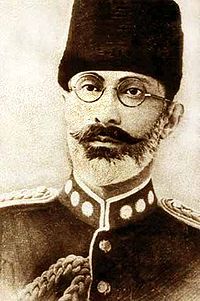- Mohammed Nadir Shah
-
Mohammed Nadir Shah
محمد نادر شاهKing of the God granted Kingdom of Afghanistan and its dependencies[1] 
King of Afghanistan Reign 16 October 1929 - 8 November 1933 (4 years, 22 days) Predecessor Habibullah Kalakāni Successor Mohammed Zahir Shah Spouse Mah Parwar Begum House Barakzai Father Mohammed Yusuf Khan Mother Sharaf Sultana Hukumat Begum Born 9 April 1883
Dehra Dun, British IndiaDied 8 November 1933 (aged 50)
Kabul, AfghanistanMohammed Nadir Shah (Pashto: محمد نادر شاه - born Mohammed Nadir; April 9, 1883 – November 8, 1933) was King of Afghanistan from 15 October 1929 until his assassination in 1933. Previously, he served as Minister of War, Afghan Ambassador to France, and as a general in the military of Afghanistan. He and his son Mohammed Zahir Shah, who succeeded him, are sometimes referred to as the Musahiban.
Contents
Background
Nadir Khan was born on 9 April 1883 in Dehra Dun, British Raj, into Mohammadzai section of Barakzai Pashtuns. His father was Muhammad Yusuf Khan and his mother was Sharaf Sultana. His paternal grandfather was Yahya Khan and his great grandfather was Sultan Muhammad Khan Telai, the brother of Dost Mohammed Khan.
Rise to power
Nadir Khan entered Afghanistan at the age of 18 when his grandfather Mohammed Yahya was authorized to return from exile by the British and Abdur Rahman Khan.[2] He became a general under King Amanullah Khan and led the Afghan National Army in the Third Anglo-Afghan War. After the war, Nadir Khan was made Minister of War and Afghan Ambassador to France.
Shortly after a rebellion by some Pashtun tribesmen and forces of Habibullah Kalakani began against the monarchy, Nadir Khan was exiled due to disagreements with King Amanullah. After the overthrow of Amanullah Khan's monarchy by Habibullah Kalakani, Nadir Khan returned to India and acquired military support from the British. He later returned to Afghanistan with his British supported armies and took most of Afghanistan from Habibullah Kalakani. By October 13 of 1929, Nadir Khan captured Kabul and subsequently sacked the city.[3] He captured Kalakani and executed him by hanging on November 3, 1929, along with some of the members of his inner circle.
King of Afghanistan
As Shah of Afghanistan Nadir quickly abolished most of Amanullah Khan's reforms, but despite his efforts to rebuild an army that had just been engaged in suppressing a rebellion, the forces remained weak[citation needed] while the religious and tribal leaders grew strong. In 1930, there were uprisings by the Pashtun Shinwari tribes of the south as well as by Tajiks of Kabul province and north of Kabul. The same year, a Soviet force crossed the border in pursuit of an Uzbek leader whose forces had been harassing the Soviets from his sanctuary in Afghanistan. He was driven back to the Soviet side by the Afghan army in April 1930, and by the end of 1931 most uprisings had been subdued.
Nadir Shah named a ten-member cabinet, consisting mostly of members of his family, and in September 1930 he called into session a loya jirga of 286 which confirmed his accession to the throne. In 1931, the King promulgated a new constitution. Despite its appearance as a constitutional monarchy, the document officially instituted a Royal oligarchy, and popular participation was merely an illusion.[citation needed]
Although Nadir Shah placated religious factions with a constitutional emphasis on orthodox denominational principles, he also took steps to modernize Afghanistan in material ways, although far less obtrusively than Amanullah. He improved road construction, especially the Great North Road through the Hindu Kush, methods of communication, and helped establish Afghanistan's first university in 1931; however, this university (Kabul University) didn't admit any students until 1932.[4] He forged commercial links with the same foreign powers that Amanullah had established diplomatic relations with in the 1920s, and, under the leadership of several prominent entrepreneurs, he initiated a banking system and long-range economic planning. Although his efforts to improve the army did not bear fruit immediately, by the time of his death in 1933 Nadir Shah had created a 40,000-strong force from almost no national army at all.
Assassination
On November 8, 1933, Nadir Shah was shot and killed by a teenager named Abdul Khaliq Hazara during a high school graduation ceremony. Khaliq Hazara was apprehended immediately after the assassination.[5] Khaliq was executed by being cut into pieces, and members of his immediate family were hanged including his father and uncle.[citation needed][6]
Criticism
Muhammad Nader Shah was criticised by some Afghan historians as an agent of Britain in Afghanistan.[7]
References and footnotes
- ^ Royal Ark
- ^ Schinasi, May (April 7, 2008). "MOḤAMMAD NĀDER SHAH". Encyclopædia Iranica (Online Edition ed.). United States: Columbia University. http://www.iranica.com/newsite/articles/unicode/ot_grp12/ot_mohnadershah_20080407.html.
- ^ Balland, D.. "AFGHĀNISTĀN". In Ehsan Yarshater. Encyclopædia Iranica (Online Edition ed.). United States: Columbia University. http://www.iranica.com/newsite/articles/v1f5/v1f5a040a.html. Retrieved 2008.
- ^ Kabul University web page: History History
- ^ Dupree, Louis: "Afghanistan", page 474. Princeton University Press, 1973
- ^ Runion, Meredith (October 2007). The History of Afghanistan. Greenwood. p. 93. ISBN 978-0313337987.
- ^ http://afghana.com/SocietyAndCulture/amanula.htm
External links
Mohammed Nadir ShahBarakzai dynastyBorn: 10 April 1880 Died: 08 November 1933Regnal titles Preceded by
Habibullah Ghazi
Emir of AfghanistanKing of Afghanistan
1929 – 1933Succeeded by
Mohammed Zahir ShahHeads of state of Afghanistan since 1709  Hotaki Empire
Hotaki Empire Durrani Empire
Durrani Empire Emirate of Afghanistan
Emirate of Afghanistan
(Barakzai dynasty) Kingdom of Afghanistan
Kingdom of Afghanistan
(Barakzai dynasty) Republic of Afghanistan
Republic of Afghanistan Democratic Republic of Afghanistan
Democratic Republic of Afghanistan
(Khalq) Democratic Republic of Afghanistan
Democratic Republic of Afghanistan
(Parcham) Republic of Afghanistan
Republic of Afghanistan Islamic State of Afghanistan
Islamic State of Afghanistan Islamic Emirate of Afghanistan
Islamic Emirate of Afghanistan Islamic Republic of AfghanistanMonarchs of Afghanistan · Presidents of AfghanistanCategories:
Islamic Republic of AfghanistanMonarchs of Afghanistan · Presidents of AfghanistanCategories:- 1883 births
- 1933 deaths
- Kings of Afghanistan
- Pashtun people
Wikimedia Foundation. 2010.
